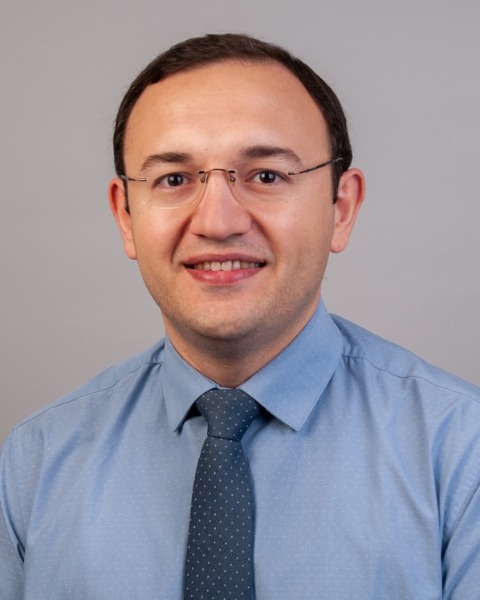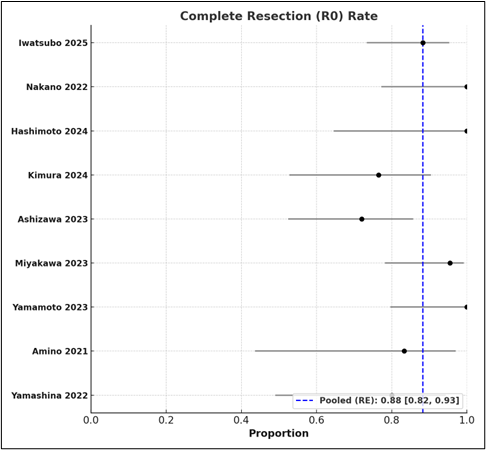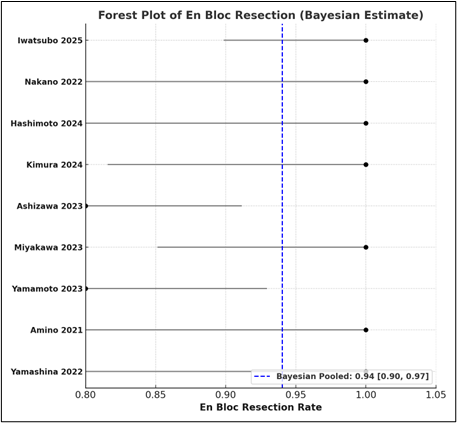Monday Poster Session
Category: Interventional Endoscopy
P3516 - Efficacy and Safety of Gel Immersion in EMR and ESD: A Systematic Review and Meta-Analysis
Monday, October 27, 2025
10:30 AM - 4:00 PM PDT
Location: Exhibit Hall

Nurlan Aliyev, MD
University of Nebraska Medical Center
Elkhorn, NE
Presenting Author(s)
Nurlan Aliyev, MD1, Kyaw Min Tun, DO2, Samantha Woller, MD, MS3, Sneh Sonaiya, MD, MPH, MBA4, Mohammed Qasswal, MD3, Aun R. Shah, MBBS, MRCP5, Douglas G. Adler, MD, FACG6
1University of Nebraska Medical Center, Elkhorn, NE; 2Creighton University School of Medicine, Omaha, NE; 3Creighton University Medical Center, Omaha, NE; 4University of Nevada, Las Vegas, Las Vegas, NV; 5CHI Health Creighton University Medical Center, Omaha, NE; 6Center for Advanced Therapeutic (CATE), Centura Health, Porter Adventist Hospital, Peak Gastroenterology, Denver, CO
Introduction: Endoscopic mucosal resection (EMR) and endoscopic submucosal dissection (ESD) are advanced endoscopic techniques that can be employed to remove superficial gastrointestinal neoplasms. Maintaining a clear visual field during these procedures is critical for safe and effective resection, particularly in challenging anatomic settings. Gel immersion (GI) has emerged as a novel method to enhance visualization and facilitate lesion removal in ESD and EMR. By providing buoyancy, optical clarity, and stability, GI may improve procedural outcomes. This systematic review and meta-analysis evaluates the safety and efficacy of gel immersion in EMR/ESD.
Methods: We conducted a systematic literature search in PubMed, Medline, Embase, Scopus, and the Cochrane Library from inception to January 12, 2025, identifying studies that used GI in ESD and EMR. Eligible studies included randomized clinical trials, cohort studies, and case series reporting on R0 and en bloc resection rates and adverse events. Preclinical studies and case reports were excluded. Composite adverse events reported in this study encompass immediate and delayed perforation and bleeding. Data was pooled using a random-effect model with Freeman-Tukey double arcsine transformation for R0 rates and Bayesian meta-analysis for en bloc resection and adverse event rates, accounting for small sample sizes and zero-event studies.
Results: Nine studies (2 ESD and 7 EMR) involving 149 lesions were included in the final analysis. The pooled R0 resection rate was 0.88 (95% CI: 0.82-0.93) (Figure 1), and the en bloc resection rate was 0.94 (95% CI: 0.90-0.97) (Figure 2), indicating high technical efficacy of the GI technique across both ESD and EMR. The overall adverse event rate was low at 0.05 (95% CI: 0.02-0.09). Subgroup analysis showed comparable R0 rates for GI ESD (0.88; 95% CI: 0.82-0.93) and gel GI EMR (0.85; 95% CI: 077-0.91), suggesting similar efficacy across techniques. All adverse events were immediate bleeding, which was treated with intraprocedural hemostatic measures. No perforation and delayed bleeding were seen.
Discussion: GI is a safe and effective technique that enhances R0 and en bloc resection rates in EMR and ESD. With a low overall adverse event rate and consistent R0 performance across ESD and EMR, GI shows promise as a valuable adjunct in therapeutic endoscopy. Further large-scale studies are warranted to validate these findings and refine clinical application.

Figure: Forest plot of complete resection (R0) rates across studies using the gel immersion technique.

Figure: Forest plot of en bloc resection rates across studies using the gel immersion technique
Disclosures:
Nurlan Aliyev indicated no relevant financial relationships.
Kyaw Min Tun indicated no relevant financial relationships.
Samantha Woller indicated no relevant financial relationships.
Sneh Sonaiya indicated no relevant financial relationships.
Mohammed Qasswal indicated no relevant financial relationships.
Aun Shah indicated no relevant financial relationships.
Douglas Adler: Boston Scientific – Consultant.
Nurlan Aliyev, MD1, Kyaw Min Tun, DO2, Samantha Woller, MD, MS3, Sneh Sonaiya, MD, MPH, MBA4, Mohammed Qasswal, MD3, Aun R. Shah, MBBS, MRCP5, Douglas G. Adler, MD, FACG6. P3516 - Efficacy and Safety of Gel Immersion in EMR and ESD: A Systematic Review and Meta-Analysis, ACG 2025 Annual Scientific Meeting Abstracts. Phoenix, AZ: American College of Gastroenterology.
1University of Nebraska Medical Center, Elkhorn, NE; 2Creighton University School of Medicine, Omaha, NE; 3Creighton University Medical Center, Omaha, NE; 4University of Nevada, Las Vegas, Las Vegas, NV; 5CHI Health Creighton University Medical Center, Omaha, NE; 6Center for Advanced Therapeutic (CATE), Centura Health, Porter Adventist Hospital, Peak Gastroenterology, Denver, CO
Introduction: Endoscopic mucosal resection (EMR) and endoscopic submucosal dissection (ESD) are advanced endoscopic techniques that can be employed to remove superficial gastrointestinal neoplasms. Maintaining a clear visual field during these procedures is critical for safe and effective resection, particularly in challenging anatomic settings. Gel immersion (GI) has emerged as a novel method to enhance visualization and facilitate lesion removal in ESD and EMR. By providing buoyancy, optical clarity, and stability, GI may improve procedural outcomes. This systematic review and meta-analysis evaluates the safety and efficacy of gel immersion in EMR/ESD.
Methods: We conducted a systematic literature search in PubMed, Medline, Embase, Scopus, and the Cochrane Library from inception to January 12, 2025, identifying studies that used GI in ESD and EMR. Eligible studies included randomized clinical trials, cohort studies, and case series reporting on R0 and en bloc resection rates and adverse events. Preclinical studies and case reports were excluded. Composite adverse events reported in this study encompass immediate and delayed perforation and bleeding. Data was pooled using a random-effect model with Freeman-Tukey double arcsine transformation for R0 rates and Bayesian meta-analysis for en bloc resection and adverse event rates, accounting for small sample sizes and zero-event studies.
Results: Nine studies (2 ESD and 7 EMR) involving 149 lesions were included in the final analysis. The pooled R0 resection rate was 0.88 (95% CI: 0.82-0.93) (Figure 1), and the en bloc resection rate was 0.94 (95% CI: 0.90-0.97) (Figure 2), indicating high technical efficacy of the GI technique across both ESD and EMR. The overall adverse event rate was low at 0.05 (95% CI: 0.02-0.09). Subgroup analysis showed comparable R0 rates for GI ESD (0.88; 95% CI: 0.82-0.93) and gel GI EMR (0.85; 95% CI: 077-0.91), suggesting similar efficacy across techniques. All adverse events were immediate bleeding, which was treated with intraprocedural hemostatic measures. No perforation and delayed bleeding were seen.
Discussion: GI is a safe and effective technique that enhances R0 and en bloc resection rates in EMR and ESD. With a low overall adverse event rate and consistent R0 performance across ESD and EMR, GI shows promise as a valuable adjunct in therapeutic endoscopy. Further large-scale studies are warranted to validate these findings and refine clinical application.

Figure: Forest plot of complete resection (R0) rates across studies using the gel immersion technique.

Figure: Forest plot of en bloc resection rates across studies using the gel immersion technique
Disclosures:
Nurlan Aliyev indicated no relevant financial relationships.
Kyaw Min Tun indicated no relevant financial relationships.
Samantha Woller indicated no relevant financial relationships.
Sneh Sonaiya indicated no relevant financial relationships.
Mohammed Qasswal indicated no relevant financial relationships.
Aun Shah indicated no relevant financial relationships.
Douglas Adler: Boston Scientific – Consultant.
Nurlan Aliyev, MD1, Kyaw Min Tun, DO2, Samantha Woller, MD, MS3, Sneh Sonaiya, MD, MPH, MBA4, Mohammed Qasswal, MD3, Aun R. Shah, MBBS, MRCP5, Douglas G. Adler, MD, FACG6. P3516 - Efficacy and Safety of Gel Immersion in EMR and ESD: A Systematic Review and Meta-Analysis, ACG 2025 Annual Scientific Meeting Abstracts. Phoenix, AZ: American College of Gastroenterology.

